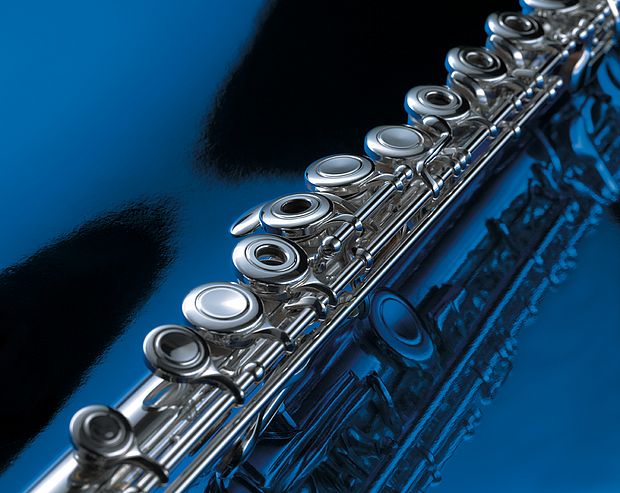Argentium™ Silver — "Untarnished by Time"

Since I built the first-in-the-world all Argentium™ silver flute in 2005, this innovation has brought the flute community an unprecedented new sterling silver alloy. Developed by the accomplished English silversmith and researcher Peter Johns, Argentium™ is essentially a high-grade sterling silver (92½ % fine) with trace (>1%) amounts of Germanium deployed into the metal. Germanium is a rare element, which lends some very unique qualities to the finished metal. These subtle, marvelous advances in metallurgy make it extremely desirable for flute construction.
Official Argentium™ Sterling Silver Website
1. Argentium™ is highly tarnish-resistant. While no claims of absolute tarnish resistance are made by the manufacturer, technicians have had extreme difficulty in getting any of this material to tarnish. This obvious benefit makes it possible for you to maintaining the "like new" finish on your flute. That shiny-fresh polish will never depart from the material, either. Argentium™ is self-healing in this regard. The Germanium atoms migrate through the silver to the surface in the case of a scratch or abrasion, ensuring that even the scratched section remains tarnish-free.
2. Argentium™ can be hardened for greater projection. Everyday Sterling Silver has a constant hardness which cannot be changed other than by working it with a hammer or a burnisher. Argentium™, however, can be thermally conditioned through a process of "precipitation hardening". By gradually raising and then lowering the temperature in an oven, the tensile strength of the alloy can be increased to almost twice that of everyday Sterling. For example, when I harden the Argentium™ head joint tubes, I find the results to be very surprising! The projection and power of the sound rivals Titanium, while retaining all of the modesty and traditional sweetness of Sterling. Since the alloy is mostly the same as traditional sterling silver, the timbre remains consistent, while the increased hardness turbo-charges the potential for concert hall projection.
Increased hardness will surely satisfy pro-level players who have always pursued the shining, subtle, and expressive tone of an old, age-hardened antique French flute. Over time, sterling silver will slowly harden, and therefore antique silver flutes are sought after by many players. If you appreciate a Louis Lot for its tone, you’ll find the properties of Argentium™ highly attractive. Precipitation hardening gives the same sonic persona as an antique flute... but without the typical struggles of playing on a refurbished artifact.
3. Argentium™ provides an increased resistance to dents, scratches & abrasion. For the world traveling professionals who expects to get a long-lasting surface finish on their delicate instruments, Argentium™ offers something like an invisible "armor" against the inevitable wear and tear that all flutes suffer. Surface digs, jewelry scratches, scrapes - these can be reduced somewhat by using Argentium™.
4. Argentium™ is good for the environment. In the process of casting, soldering and brazing the parts on a new flute, harsh chemicals such as potassium cyanide and hydrogen peroxide must be used to remove a deep tarnish known as "fire scale. With Argentium™, the need for such chemicals is gone! The material can be brazed and cast beautifully without polluting the environment.
So who is using Argentium™? Presently, Landell Flutes is presenting the innovation to an international consortium of metallurgists and industry professionals who are interested in promoting the use of this metal to the world. Since 2005, the news about Argentium™ has gradually reached the United States markets, and flutists will gradually become more aware of the material. I have chosen not to reserve an exclusive contract to use the patented material, and in fact I’m actively attempting to promote the free and open transfer of information regarding this amazing alloy to the flute community.
Feel free to email me with any questions.
Resources and Links
- Official Argentium™ Sterling Silver Website
- Argentium™ wins 2004 AJM Innovation Award
- Argentium™ as Weldable Silver Alloy (technical)
- Clearinghouse Argentium™ Info Website
- "How Silver Was Meant To Be" - Silver User's Assoc. Press Release
Titanium for Flutemaking
Technical Advantages
Lightness - In terms of actual weight, the common metals used for flutes are compared below with the specific weight for titanium:
Brass | 8.6 |
Gold | 19.3 |
Nickel | 8.8 |
Platinum | 21.37 |
Silver | 10.42 - 10.53 |
Titanium | 4.5 |

Hardness- In terms of tensile strength, titanium has a range of hardness generally more than twice that of other metals used for flutes. Although machining this material is more difficult than other metals such as stainless steel, the advantage for flute players is that the body is much more resistant to scratches or dents, and even endures being dropped on the floor.
Coloring- Titanium can be offered in a variety of color options, including a multi-colored rainbow design. Although the anodized surface will eventually wear off over time, colors can be preserved either by lacquering or by anodizing only specially engraved markings.
Chemically Inert - Titanium is completely unaffected by most chemicals. Because it forms its own oxide surface which is very hard, titanium is used in bone replacement surgery as well as long-term deep sea oil installations. Completely non-toxic, there are no health or allergy reactions known.
Permanent Joints- Because titanium cannot be soldered or brazed by normal methods, all joints are permanent and cannot be broken over time with normal handling.
Availability- The source of titanium is called "rutile", which is found in approximately .44% of the earth's crust. First discovered by an English chemist in 1795, it was not isolated in pure form until 1910 by metallurgist Matthew A. Hunter. However, it was not possible to make this metal into a structural material until about 1950 with the invention of the "Kroll" process. Today titanium is the most important material for aerospace industries, but recently it has been applied to many consumer products such as bicycle frames, eye glasses and golf clubs.
Acoustical Advantages
Because titanium has a very low specific weight and high tensile strength, the acoustic response of this metal is extremely fast, and its natural resonance is much higher than any other material in use today. Titanium is ideally suited to the high audio frequencies of the flute or piccolo, and it could also be used to advantage in other woodwind or brass instruments.
Why I Choose Titanium
For many now years I've researched and developed processes for making flutes out of such high-tech metals as titanium, niobium, or tantalum and finally concluded that the best choice would be titanium. There are inherent difficulties in machining and joining titanium parts, but a titanium flute would weigh less than half as much as a silver flute. Early flutes were made out of wood until Theobald Boehm introduced the silver flute in 1852. Louis Lot built the first all gold flute 30 years later, and Verne Powell built a platinum flute about 1832. There has been a steady progression from softer to harder materials because harder materials give a faster response that is especially welcome on rapid articulations.
With only a rough idea of the difficulties that lay ahead, I decided to build a titanium flute several years ago. It took more than a year to find a supplier of titanium tubing drawn to the correct diameter in small quantities. The tubing for 35 flutes finally arrived after another six month delay.
I first affixed a silver lip plate and risers to a titanium head joint tube with five-minute epoxy because soldering or brazing these to titanium is impossible. I experimented with this titanium head joint and found that it had a louder, brighter tone and a faster response than silver head joints. Other flutists agreed with this conclusion after playing on the titanium head joint.
In exploring the characteristics of titanium I experimented with anodizing, a method of plating metal for such purposes as inhibiting corrosion, wear, and abrasion, and decorative finishing. Anodizing consists of electrically depositing a metal substance such as aluminum from an aqueous solution in a electrolyte cell to create a hard, non-porous film on a metallic surface. The plating substance can be mixed with one or more chemicals to achieve a colored surface, so this new flute could be made in any color.
Although the basic design of the flute has not changed much over the centuries, some design concepts are functional and others aesthetic. I experimented with the radius of the outside of other lip plate under the chin and at the far side of the hole to find the best relationship for most players, then had some titanium castings of the lip plate and riser brazed on the tube. The outer edge of the lip plate functions only to protect it from bending against the flute, so I increased the stiffness of the lip plate with additional bends or facets rather than using a smooth curve for a new aesthetic appearance.
Assembling the lip plate to the tube was a major obstacle in making the titanium head joint. Flutes made from precious metals have always been soldered or brazed with torches, but titanium oxidizes so quickly that this was not possible. I learned that bicycle frames are made from titanium tubing and are welded together inside a glove box filled with inert gas. A company that specializes in producing brazing alloys for titanium and other high-tech metals suggested brazing the parts by the same method used in the aerospace and medical fields. With some new clamping techniques, this worked and a titanium head joint was finally assembled.
Titanium was difficult to machine for a crown and required special taps to cut the treads. After breaking a number of taps, I finally produced a usable crown. Next in the quest to produce a new flute was a barrel and box joints made of titanium. It took a special reamer to make the inside of the barrel tube, but it burned up after making only six good parts. It seemed clear this would be very expensive and time consuming so I decided to try assembling silver parts on a titanium tube to get a preview of how an all titanium flute would play. One month before the 1996 NFA Convention I built two titanium flute bodies and finished one flute with silver keys, so if one body were damaged there would be a spare.
When the bodies arrived, they were bent from the brazing, because the silver ribs had expanded twice as much as the titanium during brazing. As the metals cooled, the ribs contracted twice as much as the titanium. Before cutting open the tone holes, the tubing had to be straightened without damaging the body.
There were other surprises along the way, but these were the biggest challenges. Once I figured out how to handle the metal, assembling the rest of the flute was no different than a silver flute, except that the engraving had to be done by laser instead of by hand. Because titanium is so durable, the key work can be made thinner and lighter than other precious metals. Other advantages of using titanium range from responsiveness to dynamic control.
